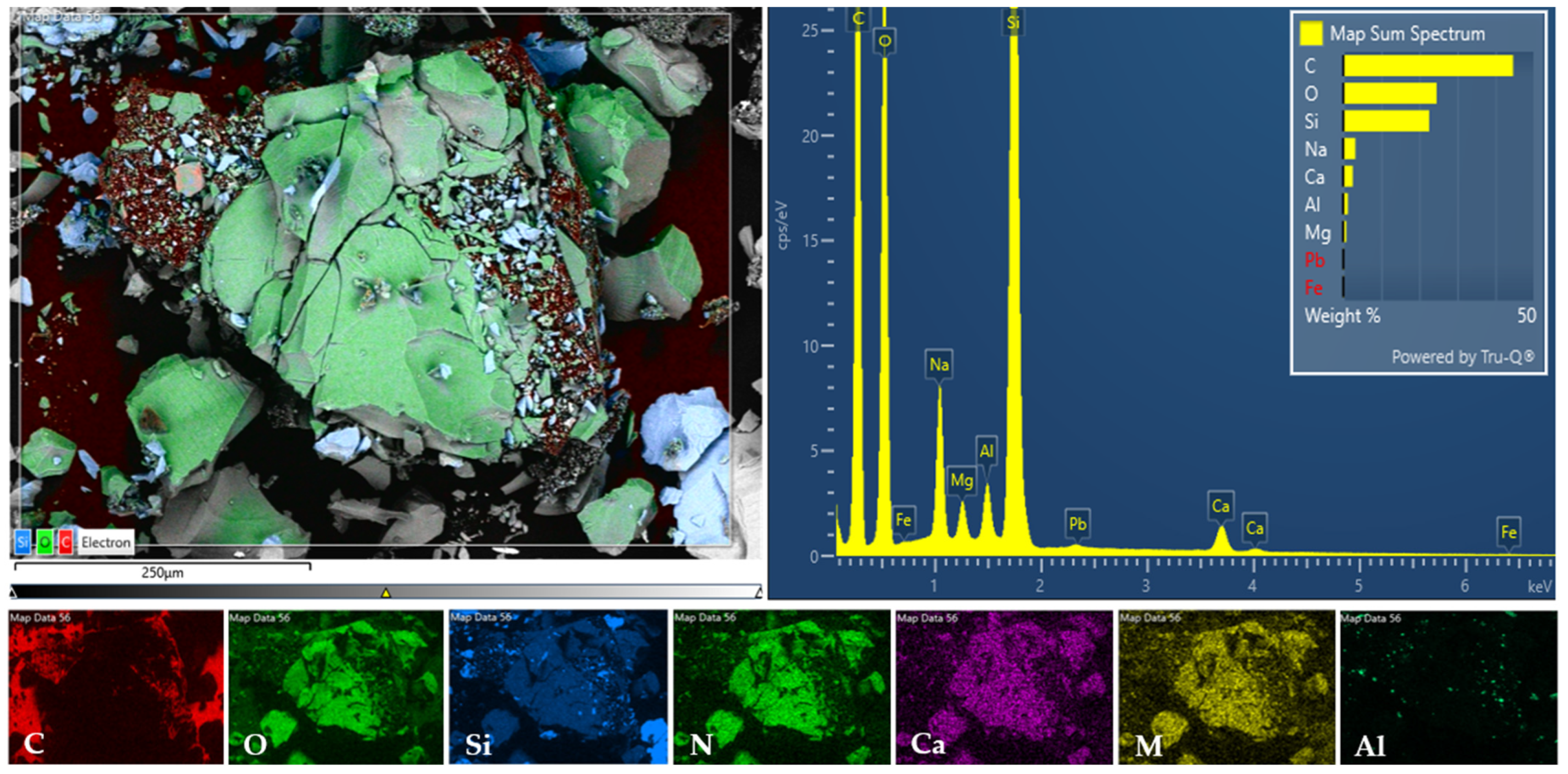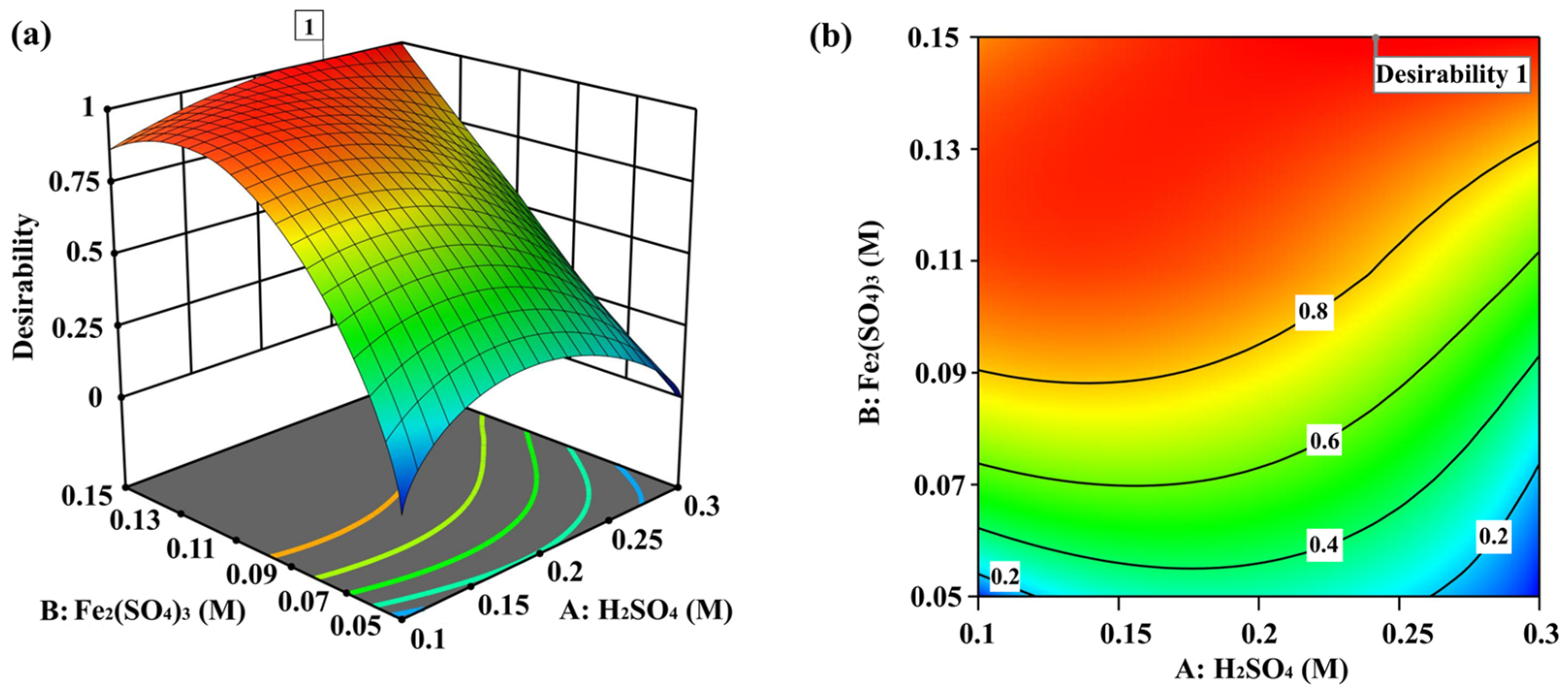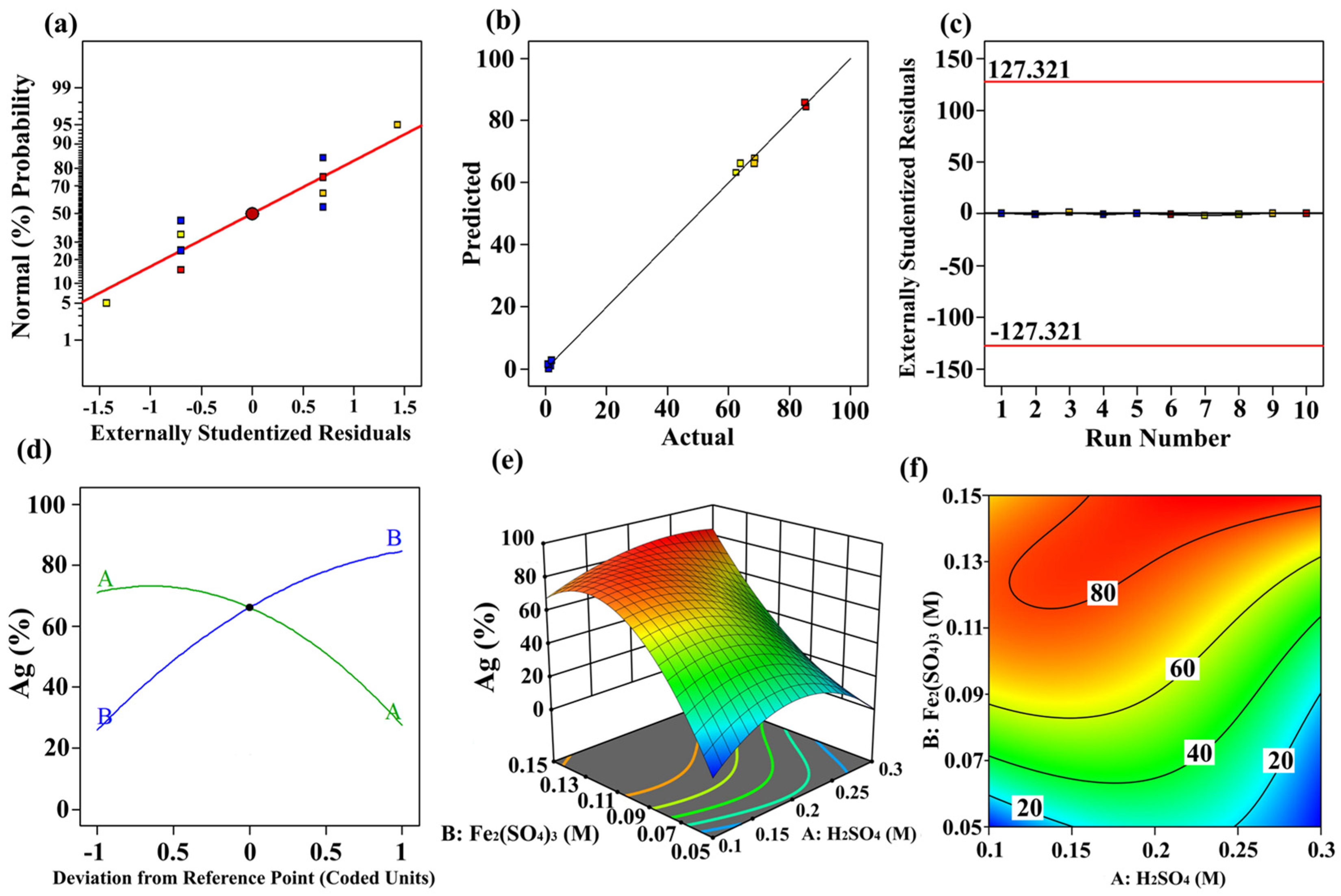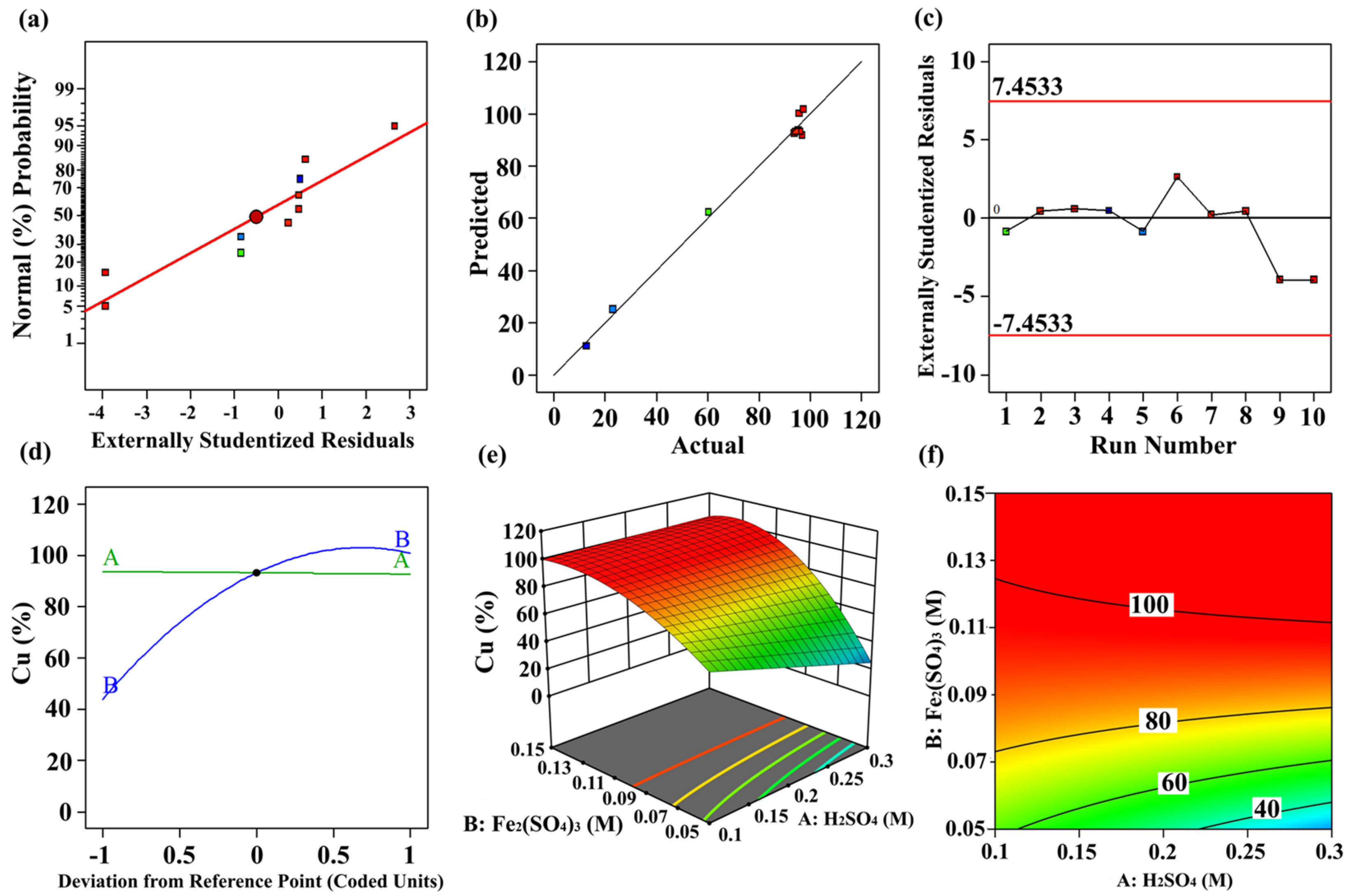3.1. Leaching Results
As previously mentioned, a full factorial experimental design within the framework of RSM was employed, consisting of ten runs, to investigate the effects of sulfuric acid and ferric sulfate concentrations on the leaching efficiency of silver and copper. The experimental plan and corresponding results, including the leaching efficiency of Ag and Cu as the response variables, are summarized in
Table 4.
Preliminary analysis of the data confirms that both H2SO4 and ferric sulfate concentrations notably influence the leaching efficiency of Ag and Cu. Silver leaching efficiency ranged from 1.07% to 85.36%, with the maximum observed in Run 4 at 0.3 M H2SO4 and 0.15 M Fe2(SO4)3. Notably, a comparable efficiency of 85.06% was achieved in Run 8 at a lower sulfuric acid concentration but higher ferric sulfate concentration (0.17 M), corresponding to an axial point outside the central design space. This outcome suggests that both parameters are critical for silver dissolution and highlights the particularly strong positive effect of ferric sulfate concentration, which enhances silver recovery even under lower acid concentration. On the other hand, at lower Fe3+ concentrations, silver recovery was minimal, reaching only about 2% in Runs 1, 2, and 9.
These findings underscore the effectiveness of ferric sulfate as an oxidizing agent for silver recovery from PV panel powder, which demonstrated a strong capacity to dissolve Ag and Cu under relatively mild conditions, namely, moderate acid concentration, ambient temperature, and relatively short reaction time. A similar trend was observed for copper, where leaching efficiency notably declined at low ferric sulfate concentrations, as evidenced in the same runs (1, 2, and 9).
Additionally, the reproducibility of the process is supported by the consistent results obtained at the design space center points. Silver leaching efficiencies of 68.47% and 63.93% were obtained in Runs 5 and 10, respectively. The corresponding copper leaching efficiencies were 96.05% and 94.32%, demonstrating both the stability and reliability of the experimental approach.
To statistically validate the observed trends, analysis of variance (ANOVA) was conducted (
Table 5 and
Table 6). A significance threshold of
p-value < 0.05 was used to identify parameters with a meaningful effect on the leaching efficiency [
26,
33,
34]. The ANOVA results indicated that both sulfuric acid and ferric sulfate concentrations, along with their quadratic terms, notably influenced silver leaching efficiency at the 95% confidence level (
Table 5).
Based on the ANOVA, which showed a non-significant lack of fit, a regression model was developed to predict silver leaching efficiency within the experimental design space. This model, presented in
Table 7, incorporates both linear and quadratic terms, capturing the non-linear behavior evident in the experimental data. The inclusion of quadratic terms suggests that leaching efficiency improves with increasing concentrations of H
2SO
4 and Fe
2(SO
4)
3 up to an optimum point, beyond which the efficiency may decrease due to curvature effects. Li et al., who used a leaching system containing sulfuric acid and hydrogen peroxide for dissolution of silver and aluminum from PV panels, observed similar trends for the leaching and oxidizing agent’s concentrations [
32]. These results suggest that ferric sulfate achieves almost comparable leaching efficiency under milder conditions, which demonstrates its promise as an alternative oxidant.
The model exhibited excellent statistical performance, with a predicted R
2 of 0.9711, an adjusted R
2 of 0.9945, and an R
2 of 0.9988, indicating strong agreement between predicted and observed values (
Table 5). The model also demonstrated high statistical reliability, as evidenced by a low standard deviation of 2.77 and a non-significant lack of fit (
p = 0.6117). Furthermore, the coefficient of variation (C.V.) was 6.3%, reflecting high precision, while the adequate precision value exceeded the recommended threshold, confirming a strong signal-to-noise ratio [
26].
Overall, these results affirm that the developed model is statistically robust and well-suited for predicting and optimizing silver leaching efficiency from the PV panel powder.
To further investigate the influence of process parameters on copper leaching efficiency, ANOVA was performed for the Cu dissolution response. The results, summarized in
Table 6, indicate that ferric sulfate concentration, along with its quadratic term and its interaction with sulfuric acid concentration, are statistically significant factors. The model demonstrated strong significance with an overall
p-value of 0.0003, confirming excellent fit to the experimental data and an insignificant lack of fit.
Although sulfuric acid concentration was not a statistically significant factor, due to its relatively high
p-value, it was retained in the model to maintain model hierarchy. Also, the
p-value for the AB
2 term is 0.0625, slightly above the typical 0.05 threshold for statistical significance. However, this term was retained in the final model to have better model fitting, which improved the overall model performance metrics (R
2, adjusted R
2, and predicted R
2) and helped capture the curvature observed in the experimental data. Based on the ANOVA results, which confirm a non-significant lack of fit (
Table 6), a regression model was developed to predict copper leaching efficiency based on the actual experimental parameters. This model is presented in
Table 7.
The final model exhibited strong predictive capability, with a predicted R
2 of 0.9084, an adjusted R
2 of 0.9800, and an overall R
2 of 0.9911, indicating excellent agreement between predicted and observed responses. The model also showed good statistical robustness, with a relatively low standard deviation of 4.65 and a non-significant lack of fit (
p = 0.1662). Additionally, the coefficient of variation (C.V.) was 6.07%, and the adequate precision greatly exceeded the recommended threshold of 4, suggesting a high signal-to-noise ratio [
26]. These findings confirm that the developed model for predicting copper leaching efficiency is statistically sound and well-suited for process optimization.
The statistical model developed from the experimental data was further evaluated through graphical analysis across the investigated parameter range.
Figure 3a presents the normal probability plot of residuals, where the data points closely follow a straight line, indicating that the residuals are normally distributed and that the assumption of normality is satisfied. The correlation between predicted and actual silver leaching efficiency values is shown in
Figure 3b. The proximity of the data points to the diagonal line demonstrates strong agreement between experimental and predicted results, further confirming the accuracy of the regression model.
Figure 3c illustrates the externally studentized residuals plotted against the run number. The residuals are randomly scattered around the zero line, with no apparent patterns, indicating a good model fit and the absence of systematic error.
Figure 3d presents the perturbation plots, which show the sensitivity of silver leaching efficiency to variations in sulfuric acid and ferric sulfate concentrations around the center point.
The three-dimensional response surface plot in
Figure 3e illustrates the effect of H
2SO
4 and ferric sulfate concentrations on silver leaching efficiency. The plot reveals that increasing sulfuric acid concentration enhances leaching efficiency up to an optimum point (~0.2 M), beyond which further increases have a detrimental effect, particularly at ferric sulfate concentrations lower than 0.13 M. In contrast, ferric sulfate exhibits a consistently positive influence on silver leaching when sulfuric acid is present in more than 0.2 M concentrations. For enhanced clarity, a corresponding two-dimensional contour plot is provided in
Figure 3f, highlighting the regions associated with the highest silver leaching efficiencies.
Overall, these graphical analyses confirm that the developed model is statistically valid and reliable for predicting silver leaching efficiency across the tested ranges of sulfuric acid and ferric sulfate concentrations.
The predictive model for copper leaching efficiency was also evaluated using diagnostic plots. The normal probability plot of residuals (
Figure 4a) shows that the data points align closely with the reference line, confirming that the residuals are normally distributed and that the model satisfies the assumption of normality.
Figure 4b compares the predicted and actual values for copper leaching efficiency. The close alignment of data points along the diagonal line indicates strong model accuracy and minimal deviation from experimental results.
Figure 4c displays the distribution of externally studentized residuals across the experimental runs. All residuals fall within the control limits (±7.45), and no apparent patterns are observed, suggesting random distribution and the absence of systematic bias in the model.
Figure 4d presents the perturbation plot based on the model around the center point. The plot reveals a minimal influence of sulfuric acid concentration on copper leaching efficiency, while ferric sulfate concentration exhibits a strong positive effect.
The three-dimensional surface plot in
Figure 4e further illustrates the relationship between H
2SO
4 and ferric sulfate concentrations and their effect on copper leaching efficiency. The plot indicates that increasing ferric sulfate concentration significantly enhances copper dissolution, particularly at higher sulfuric acid concentrations. At 0.3 M H
2SO
4, raising the ferric sulfate concentration from 0.05 M to 0.15 M increased the copper dissolution rate from approximately 22% to nearly 100%. At the highest ferric sulfate level of 0.15 M, sulfuric acid concentration has a negligible effect, indicating that ferric sulfate is the dominant factor. For additional clarity, a corresponding two-dimensional contour plot (
Figure 4f) highlights the regions associated with the highest copper leaching efficiencies.
Collectively, these diagnostic plots confirm the robustness and predictive reliability of the model. The results demonstrate that copper leaching efficiency is primarily driven by ferric sulfate concentration, and the model is well-suited for use in process optimization. In 2019, Xiaohua Li et al. observed a similar trend when using FeCl
3 (Fe (III)) for the leaching of copper from chalcopyrite [
35].
















